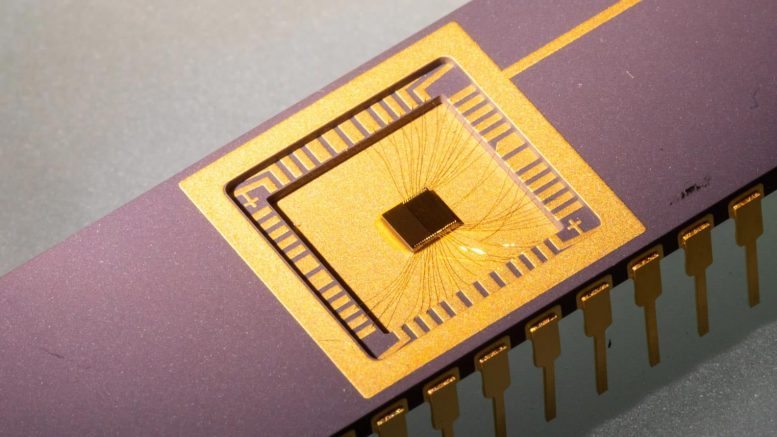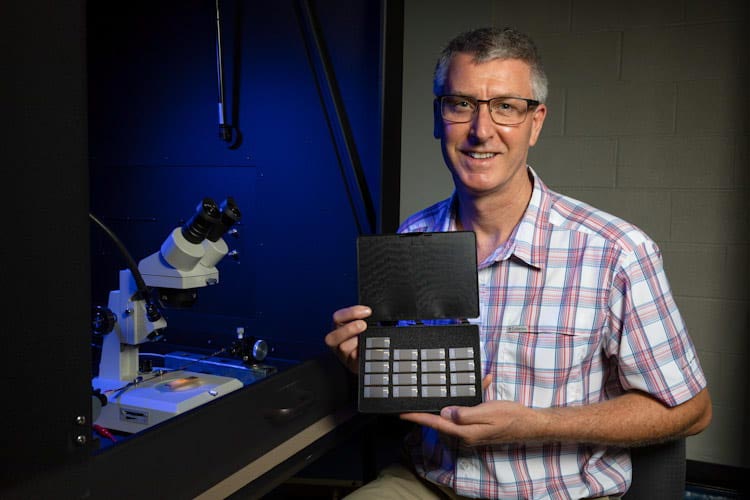
Posted on 10/02/2020 7:09:57 AM PDT by Red Badger

Researchers build circuit that harnessed the atomic motion of graphene to generate an electrical current that could lead to a chip to replace batteries.
============================================================================
A team of University of Arkansas physicists has successfully developed a circuit capable of capturing graphene’s thermal motion and converting it into an electrical current.
“An energy-harvesting circuit based on graphene could be incorporated into a chip to provide clean, limitless, low-voltage power for small devices or sensors,” said Paul Thibado, professor of physics and lead researcher in the discovery.
The findings, published in the journal Physical Review E, are proof of a theory the physicists developed at the U of A three years ago that freestanding graphene — a single layer of carbon atoms — ripples and buckles in a way that holds promise for energy harvesting.
The idea of harvesting energy from graphene is controversial because it refutes physicist Richard Feynman’s well-known assertion that the thermal motion of atoms, known as Brownian motion, cannot do work. Thibado’s team found that at room temperature the thermal motion of graphene does in fact induce an alternating current (AC) in a circuit, an achievement thought to be impossible.
===========================================================================

Graphene chip testing — A sample energy-harvesting chip under development. Credit: University of Arkansas
==============================================================================
In the 1950s, physicist Léon Brillouin published a landmark paper refuting the idea that adding a single diode, a one-way electrical gate, to a circuit is the solution to harvesting energy from Brownian motion. Knowing this, Thibado’s group built their circuit with two diodes for converting AC into a direct current (DC). With the diodes in opposition allowing the current to flow both ways, they provide separate paths through the circuit, producing a pulsing DC current that performs work on a load resistor.
Additionally, they discovered that their design increased the amount of power delivered. “We also found that the on-off, switch-like behavior of the diodes actually amplifies the power delivered, rather than reducing it, as previously thought,” said Thibado. “The rate of change in resistance provided by the diodes adds an extra factor to the power.” The team used a relatively new field of physics to prove the diodes increased the circuit’s power. “In proving this power enhancement, we drew from the emergent field of stochastic thermodynamics and extended the nearly century-old, celebrated theory of Nyquist,” said coauthor Pradeep Kumar, associate professor of physics and coauthor.
According to Kumar, the graphene and circuit share a symbiotic relationship. Though the thermal environment is performing work on the load resistor, the graphene and circuit are at the same temperature and heat does not flow between the two.
VIDEO OF PROCESS AT LINK:
Thibado’s energy-harvesting circuit uses the atomic motion of graphene to generate an electrical current that can perform work. Credit: Illustration by Ashley Acord.
=========================================================================
That’s an important distinction, said Thibado, because a temperature difference between the graphene and circuit, in a circuit producing power, would contradict the second law of thermodynamics. “This means that the second law of thermodynamics is not violated, nor is there any need to argue that ‘Maxwell’s Demon’ is separating hot and cold electrons,” Thibado said.
The team also discovered that the relatively slow motion of graphene induces current in the circuit at low frequencies, which is important from a technological perspective because electronics function more efficiently at lower frequencies.

Paul Thibado, professor of physics, holds prototype energy-harvesting chips. Credit: Russell Cothren, University of Arkansas
=============================================================================
“People may think that current flowing in a resistor causes it to heat up, but the Brownian current does not. In fact, if no current was flowing, the resistor would cool down,” Thibado explained. “What we did was reroute the current in the circuit and transform it into something useful.”
The team’s next objective is to determine if the DC current can be stored in a capacitor for later use, a goal that requires miniaturizing the circuit and patterning it on a silicon wafer, or chip. If millions of these tiny circuits could be built on a 1-millimeter by 1-millimeter chip, they could serve as a low-power battery replacement.
Reference: 2 October 2020, Physical Review E. DOI: 10.1103/PhysRevE.102.042101
The University of Arkansas holds several patents pending in the U.S. and international markets on the technology and has licensed it for commercial applications through the university’s Technology Ventures division. Researchers Surendra Singh, University Professor of physics; ; Hugh Churchill, associate professor of physics; and Jeff Dix, assistant professor of engineering, contributed to the work, which was funded by the Chancellor’s Commercialization Fund supported by the Walton Family Charitable Support Foundation.
The idea of harvesting energy from graphene is controversial because it refutes physicist Richard Feynman’s well-known assertion that the thermal motion of atoms, known as Brownian motion, cannot do work. Thibado’s team found that at room temperature the thermal motion of graphene does in fact induce an alternating current (AC) in a circuit, an achievement thought to be impossible.
I figure it'll be a "lab accident". If he survives though, and the idea pans out, this could make its first commercial appearance in an iPhone, iPad, or Apple Watch. Thanks Red Badger.

Yes, you are correct. My mind immediately jumped to present-day mass “green energy” politics. I could easily imagine a world where power is needed, in very tiny amounts, at many trillions of nodes in a network for monitoring literally every human activity in real-time.
The graphene acts as the AC generator in a rather normal power supply circuit..............
..........or a Tesla.................
Particles in both liquids and gases (collectively called fluids) move randomly. This is called Brownian motion. They do this because they are bombarded by the other moving particles in the fluid. Larger particles can be moved by light, fast-moving molecules.
Brownian motion is named after the botanist Robert Brown, who first observed this in 1827. He used a microscope to look at pollen grains moving randomly in water. At this point, he could not explain why this occurred.
But in 1905, physicist Albert Einstein explained that the pollen grains were being moved by individual water molecules. This confirmed that atoms and molecules did exist, and provided evidence for particle theory.BBC bitesize guides: Kinetic particle theory and state changes: Brownian motion
Instead of a Plaid, they'll have a Brown model.
It should necessarily also serve as a heat sink with possible cooling usages as well as an electrical source. My question is how efficient is it? Is its efficiency greater than current thermocouples/thermopiles, recognizing the possible advantage of a greatly decreased size for such devices?
additional stream-of-consciousness sidebars:
http://thermoelectrics.matsci.northwestern.edu/thermoelectrics/history.html
https://www.electronicdesign.com/power-management/article/21801833/what-is-the-piezoelectric-effect
Bob Dylan - Visions of Johanna
https://www.youtube.com/watch?v=AwuCF5lYqEE
Of course you are right, and I even once bought a small Peltier effect ice chest at Costco. It was expensive and did not cool particularly well compared to a bag of ice. But, salable consumer products do exist.
This can only work if the environment itself provides an unlimited (or at least sufficient) source of thermal energy.
Fortunately, as long as you are above absolute zero, it does.
So, the graphene converts its own thermal energy to electricity and the environment brings the graphene back to thermal equilibrium. The Laws of Thermodynamics remain satisfied. The device just sucks energy out of the nearly unlimited thermal energy source we call the environment.
Why didn’t I think of this.
If this is in fact converting heat into electricity, it should also have a refrigerating effect or it would violate the conservation of energy law.
+++++
I agree. The temperature of the environment would fall. At least until you convert that energy to heat in some electronic device. But while that energy is stored your statement is correct.
That's the name I was trying to remember. Lol The problem with these devices and all thermoelectric generation is its poor efficiency. If this device is an improvement, it may have great possibilities; even for powering spacecraft.
The article makes no sense. For starters, diodes all have a “forward voltage” drop, a threshold below which they don’t conduct. This turns them into a power absorber at low voltages. The forward voltage of a diode is generally around a half a volt. Johnsonian noise in a material is measured in micro volts. Real diodes simply wouldn’t conduct the noise at all, they would simply absorb any power that is present.
Words like “symbiotic relationships” deal with living things, not circuits. Electrical circuits only can have physical characteristics.
Words like “We also found that the on-off, switch-like behavior of the diodes actually amplifies the power delivered, rather than reducing it, as previously thought,” said Thibado. “The rate of change in resistance provided by the diodes adds an extra factor to the power.” are simply nonsense.
Quite so. The military applications alone would be revolutionary.
When we reach the heat death of the Universe, it'll stop; Brownian motion .NE. zero-point energy, which derives from the non-commutation of the position and momentum operators and Heisenberg's Uncertainty Principle.
Yeah, except for Feynman's quote that "if it doesn't agree with experiment, it's WRONG."
Nice. Keep the Chinese students away from this research.
Maybe there IS an exception to the rule, but Arkansas...
Yeah but he excelled at thinking outside the box, which “trumps” hardware. No slight on this guy, I know exactly nothing about him.
Disclaimer: Opinions posted on Free Republic are those of the individual posters and do not necessarily represent the opinion of Free Republic or its management. All materials posted herein are protected by copyright law and the exemption for fair use of copyrighted works.